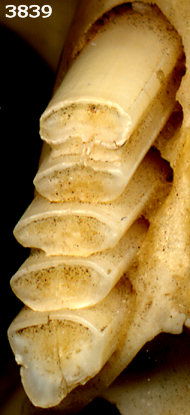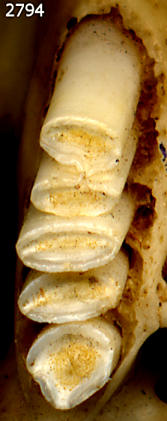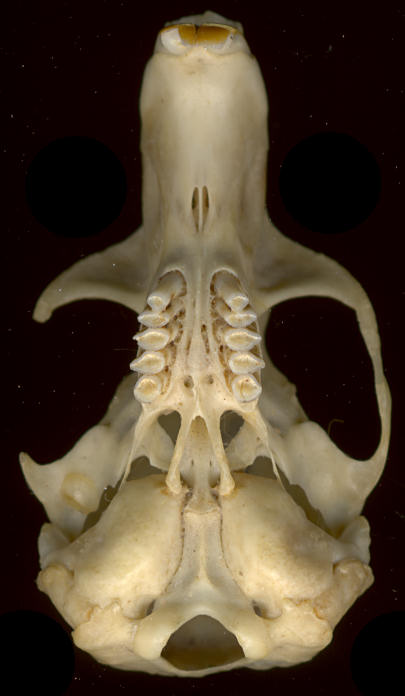Pocket gophers are fossorial (living underground) animals widespread in the West and to the south through Central America. They show a number of characteristics that often are associated with fossorial life, including small eyes, small ears, a robust build, and stout, curved claws on massive forelimbs. The tail is short and rather scantily haired, apparently acting in part as a sensitive antenna for rapid backwards movement through the tunnels. The lower jaw is heavy and possesses a well developed coronoid process. The tooth formula is 1/1, 0/0, 1/1, 3/3, and teeth are rootless and the enamel of the cheek teeth is reduced. The anterior surface of the incisors is flat and broad; upper incisors may be grooveless or possess one or two grooves running their length.
Over 300 geomyid taxa have been named, with many at the species-subspecies levels being rather subjective because of the generally allopatric distribution and the ease with which populations are isolated because of unsuitable edaphic (soil) conditions.
Three genera and six species occur in the region, three of them in the immediate vicinity of El Paso. Pocket gophers are highly antisocial, both within their own species and interspecifically. As a result, there normally is only one adult per burrow system and, on a microgeographic scale, only one species in any one place (ranges occasionally interdigitate, however).
Where two or more species occur in the same region, the ecological niches tend to be divided up. In the immediate El Paso region, for example, three species occur, and their ranges are divided up according to soils: one occurs in deep sandy soils, one in deep hard soils, and one in shallow rocky soils.
Burrow systems are marked on the surface by mounds of soil pushed out of the tunnels. Entrances normally are plugged by soil. Living in more or less closed off quarters, gophers are subjected to relatively high concentrations of CO2 and have been shown in the lab to be relatively insensitive to such concentrations compared to non-fossorial mammals. Where snow accumulates during the cold season, tunnels may be constructed through the snow and eventually plugged with soil; such castings, during and following snow melt, may aid in slowing meltwater runoff, allowing it to sink into the soil.
In a sense, gophers act as overgrown earthworms to the extent that they bring subsurface soil to the surface, eventually burying rocks, organic material, etc. The disturbed soil also may serve as habitat for plants adapted to disturbed conditions (not always a happy thing for farmers). Gopher mounds may disturb agricultural lands by burying crop plants. In irrigated areas, their tunnels may drain irrigation ditches and allow erosion.
Food is primarily of underground plant parts, but often above-ground parts may be clipped from around the entrances, and some above-ground parts may be pulled under on occasion.
Smithsonian Fieldguide and link to Animal Biodiversity Web.
 Cratogeomys castanops—Yellow-faced
Pocket Gopher. This is a taxon that has undergone generic name changes in recent years, from Cratogeomys to Pappogeomys (Cratogeomys) (subgenera are indicated by placing the subgenus
in parentheses after the generic name) to Cratogeomys once again. The problem has not been that there are not recognized differences between Mexican Pappogeomys and the Southwestern
species, but whether these differences are subgeneric or generic. At the moment, the general agreement seems to be that they are of generic level.
Cratogeomys castanops—Yellow-faced
Pocket Gopher. This is a taxon that has undergone generic name changes in recent years, from Cratogeomys to Pappogeomys (Cratogeomys) (subgenera are indicated by placing the subgenus
in parentheses after the generic name) to Cratogeomys once again. The problem has not been that there are not recognized differences between Mexican Pappogeomys and the Southwestern
species, but whether these differences are subgeneric or generic. At the moment, the general agreement seems to be that they are of generic level.
The upper incisor has a groove (slightly toward the medial side); and P4, M1, and M2 lack posterior enamel plates. The posterior surfaces of the first two lower molars lack enamel plates. This is a large gopher found in our area in relatively deep, but hard soils. At present, in the immediate El Paso area, it appears to have been eliminated from the western part of the Hueco Bolson (an early record had it on the Fort Bliss golf course), but is still present on the eastern edge.
Fig. 1. Upper right cheek teeth of the Yellow-faced Pocket Gopher. P4 could easily be mistaken for two teeth, but the alveolus shows clearly that a single tooth is represented. Note the absence of enamel on P4, M1, and M2.
Farther east in the Trans-Pecos, it has been shown to be able to invade territory held by Thomomys bottae during drought conditions, but retreats during more mesic times.
The geographic range extends into southeastern Colorado and southwestern Kansas on the north to San Luis Potosí on the south. There are archaeological records from Santa Fe and historic occurrence in the valley at Albuquerque, but it appears extirpated from the area. There also is a Mid-Holocene record from the San Juan Basin of northwestern New Mexico. In southern New Mexico, the Rio Grande Valley marks the westernmost margin of its range; there is an undated (possibly Holocene) occurrence as a fossil at U-Bar Cave in the bootheel of New Mexico, however.
 Geomys arenarius—Desert Pocket Gopher.
There are two major dental differences between Geomys and Cratogeomys. The former has two longitudinal grooves on each upper incisor rather than one, and M1 and M2 have complete
posterior enamel plates. El Paso is the type locality. The morphological differences between G. arenarius and G. bursarius appear minor (primarily presence or absence of a prominent
knob at the end of the squamosal arm of the zygoma, over the middle of the jugal). At times, this species as been considered conspecific with bursarius, at other times not; it currently is
considered to be a separate species from G. bursarius. The two taxa are not known to occur sympatrically. G. arenarius is recorded from the Rio Grande Rift as far north as east of San
Antonio, NM.
Geomys arenarius—Desert Pocket Gopher.
There are two major dental differences between Geomys and Cratogeomys. The former has two longitudinal grooves on each upper incisor rather than one, and M1 and M2 have complete
posterior enamel plates. El Paso is the type locality. The morphological differences between G. arenarius and G. bursarius appear minor (primarily presence or absence of a prominent
knob at the end of the squamosal arm of the zygoma, over the middle of the jugal). At times, this species as been considered conspecific with bursarius, at other times not; it currently is
considered to be a separate species from G. bursarius. The two taxa are not known to occur sympatrically. G. arenarius is recorded from the Rio Grande Rift as far north as east of San
Antonio, NM.
Fig. 2. Upper right cheek teeth of Geomys arenarius. Note the posterior enamel plate on M1 and M2.
This is the common gopher along the floodplain of the Rio Grande in southern New Mexico and the El Paso and also in sandy soils of the bolsons.
Geomys knoxjonesi—Jones' Pocket Gopher. This species was named as a subspecies of G. bursarius in 1987, but later shown by chromosomal evidence to be a separate, cryptic species, though there is some doubt still being expressed. Distribution is in southeastern New Mexico and about a dozen counties in adjacent Texas. Morphologically, this animal appears to be slightly smaller in body and cranial size than G. bursarius, but sure identification requires genetic information. Geomys knoxjonesi also shows shared genetic characters with G. arenarius, and it's an open question whether two species or one are represented. If one, G. arenarius has priority.
Geomys bursarius—Plains Pocket Gopher. As the name implies, this gopher has its center in the Great Plains. In terms of our region, then, it is limited to the eastern part of New Mexico, east of the eastern mountain ranges. Its larger range is from barely into southern Canada south to the Gulf Coast in Texas and Louisiana.
 Thomomys differs from the other two genera by a number of
features. The most easily noted is the absence of grooves on the upper incisors (a very faint groove sometimes can be seen, but never prominent enough to allow confusion with Cratogeomys).
The cheek teeth differ considerably from either of the other two genera.
Thomomys differs from the other two genera by a number of
features. The most easily noted is the absence of grooves on the upper incisors (a very faint groove sometimes can be seen, but never prominent enough to allow confusion with Cratogeomys).
The cheek teeth differ considerably from either of the other two genera.
Fig. 3 (right). Ventral view of the skull of Thomomys talpoides. The "pear-shaped" M1 and M2 are quite different from those of the other genera. The right zygomatic arch and incisor are broken.
Thomomys bottae—Botta's Pocket Gopher; Thomomys umbrinus—Southern Pocket Gopher. The nomenclature of these two species was badly scrambled by a decision of Hall (1981) to interpret some local occurrences of hybrids as evidence of intergradation; on this basis, he lumped the two taxa into one species (with T. umbrinus having priority). Various workers have followed Hall (though most have not), and thus one has to be careful to determine which species actually is being treated in a publication. In general, northern populations (from as far north as Idaho and Colorado) are T. bottae, while Mexican populations are mostly T. umbrinus. In some areas in Arizona, the bootheel of New Mexico, and northern Mexico, both species occur. In this area, T. umbrinus is a montane form and T. bottae occurs in the lowlands.
In New Mexico, bottae is widespread in the southern and central portions of the state and in the lowlands in the northern portions; it also is widespread in Trans-Pecos Texas. T. umbrinus occurs in New Mexico only in the high country of the Animas Mountains of Hidalgo County, in the bootheel. In the highlands of northern New Mexico (Sangre de Cristo, Jemez, San Mateo [the northern San Mateo]), bottae is replaced in the high country by Thomomys talpoides.
Botta's Pocket Gopher generally is pushed out of the more desirable habitat when it occurs with Geomys or Cratogeomys, but spreads out into a variety of habitats in their absence. Thus around El Paso, it is limited to the poor, shallow, rocky soils of the desert ranges. Farther north, it occurs in the somewhat better high-mountain habitat. North of the ranges of the other species in central and northern New Mexico, it occurs both in high mountain habitat (where not excluded by T. talpoides) and in the deep valley soils. Body size tends to vary with the depth and nature of the soil.
Thomomys talpoides—Northern Pocket Gopher. This gopher occurs from well up into Canada in the plains west to central British Columbia, Washington, and Oregon, south to northeastern California and northern Nevada and east to northern New Mexico and eastern Colorado. Although a montane form in the south, it—like many other mammals limited to high elevations in the southern portions of their ranges—spreads also into the valleys farther north.
In the late Pleistocene, this taxon occurred on the east side of the Guadalupe Mountains to as low as 1280 m; it also occurred east of Orogrande at the edge of the Hueco Bolson. Deposits also include T. bottae, suggesting that they were dividing up the habitat, with talpoides on the cooler, more mesic slopes and bottae on the more xeric, hotter southfacing slopes. Alternatively, these sites may have been in a tension zone between the two species, with the boundary between them sweeping back and forth through the site areas with short-term climatic fluctuations.
Last Update: 11 Feb 2008
Centennial Museum and Department of Biological Sciences, The University of Texas at El Paso